Culturally Safe Care: A Reflection on Indigenous Health Perceptions
VerifiedAdded on 2023/06/08
|5
|1160
|463
Essay
AI Summary
This essay is a reflective account of the social and cultural factors that have shaped the author's views on Aboriginal and Torres Strait Islander (ATSI) peoples and their health. It highlights the influence of family upbringing, exposure to diverse cultures, and personal experiences, particularly a relationship with an elderly Maori woman, on fostering empathy and understanding towards indigenous health needs. The reflection also addresses the impact of historical trauma, discrimination, and reduced help-seeking behavior within ATSI communities. The author emphasizes the importance of culturally safe care, treating individuals as equals, and incorporating cultural sensitivity into therapeutic engagement to improve health outcomes for Aboriginal and Torres Strait Islander populations. Desklib offers a platform to explore similar essays and resources for students.
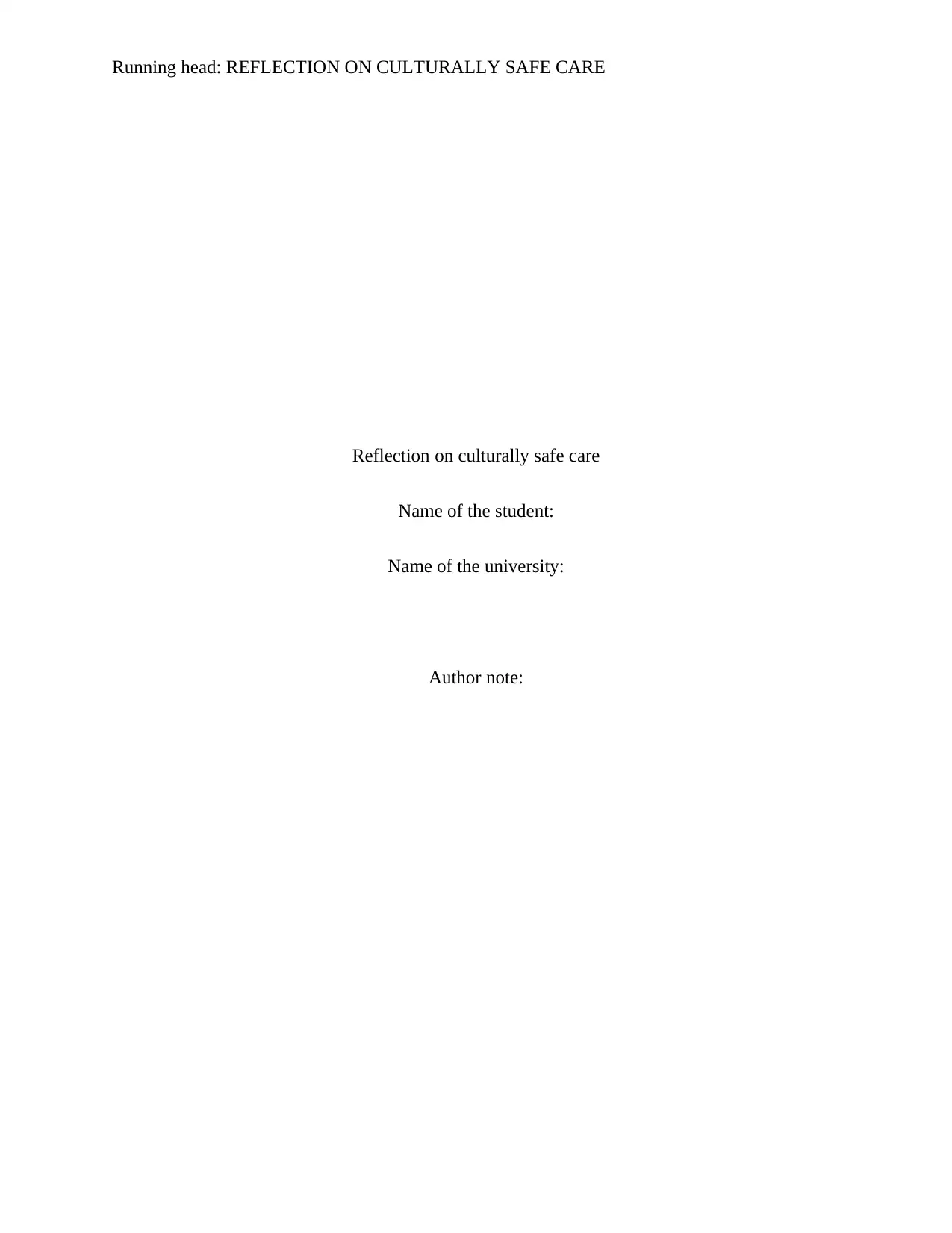
Running head: REFLECTION ON CULTURALLY SAFE CARE
Reflection on culturally safe care
Name of the student:
Name of the university:
Author note:
Reflection on culturally safe care
Name of the student:
Name of the university:
Author note:
Paraphrase This Document
Need a fresh take? Get an instant paraphrase of this document with our AI Paraphraser
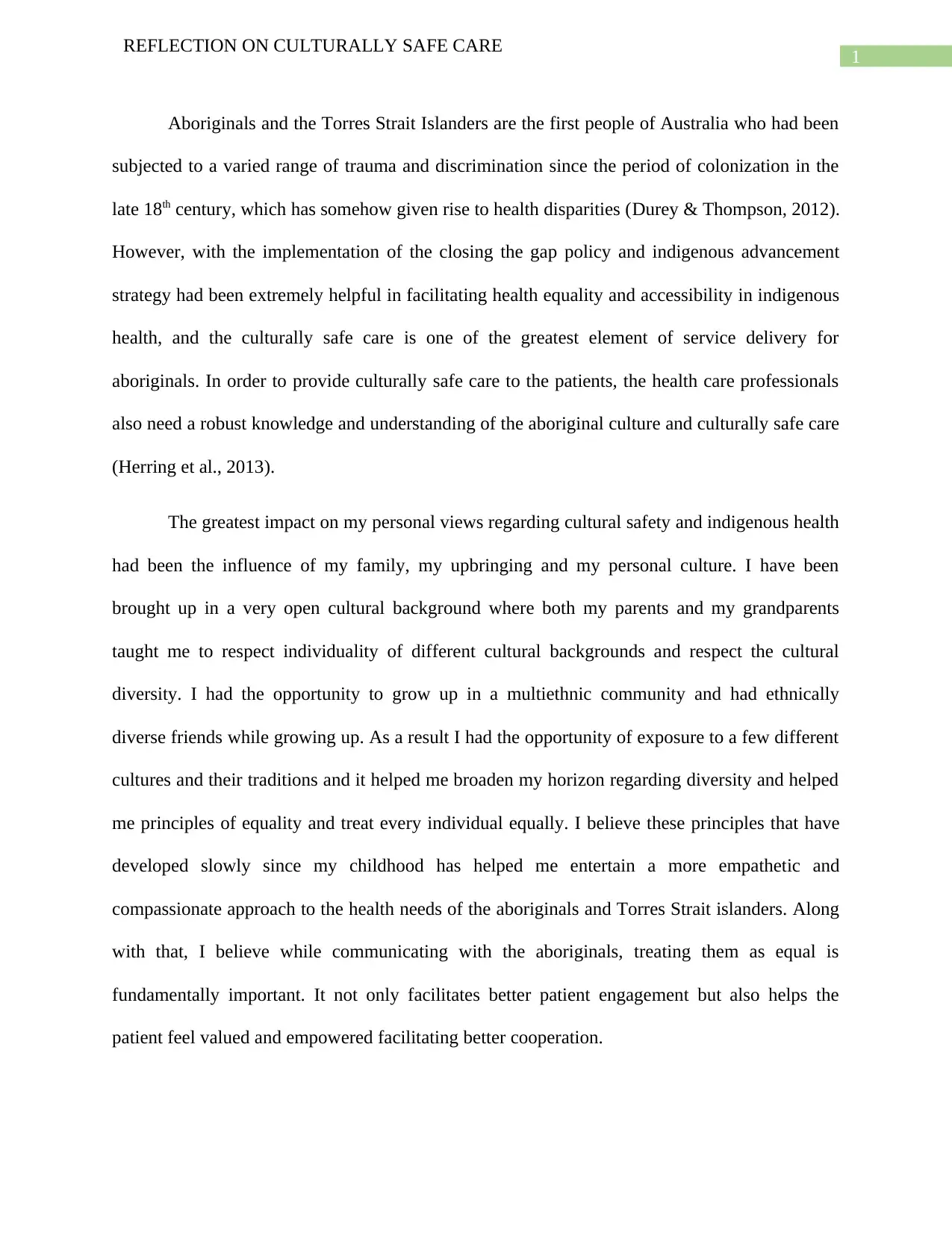
1
REFLECTION ON CULTURALLY SAFE CARE
Aboriginals and the Torres Strait Islanders are the first people of Australia who had been
subjected to a varied range of trauma and discrimination since the period of colonization in the
late 18th century, which has somehow given rise to health disparities (Durey & Thompson, 2012).
However, with the implementation of the closing the gap policy and indigenous advancement
strategy had been extremely helpful in facilitating health equality and accessibility in indigenous
health, and the culturally safe care is one of the greatest element of service delivery for
aboriginals. In order to provide culturally safe care to the patients, the health care professionals
also need a robust knowledge and understanding of the aboriginal culture and culturally safe care
(Herring et al., 2013).
The greatest impact on my personal views regarding cultural safety and indigenous health
had been the influence of my family, my upbringing and my personal culture. I have been
brought up in a very open cultural background where both my parents and my grandparents
taught me to respect individuality of different cultural backgrounds and respect the cultural
diversity. I had the opportunity to grow up in a multiethnic community and had ethnically
diverse friends while growing up. As a result I had the opportunity of exposure to a few different
cultures and their traditions and it helped me broaden my horizon regarding diversity and helped
me principles of equality and treat every individual equally. I believe these principles that have
developed slowly since my childhood has helped me entertain a more empathetic and
compassionate approach to the health needs of the aboriginals and Torres Strait islanders. Along
with that, I believe while communicating with the aboriginals, treating them as equal is
fundamentally important. It not only facilitates better patient engagement but also helps the
patient feel valued and empowered facilitating better cooperation.
REFLECTION ON CULTURALLY SAFE CARE
Aboriginals and the Torres Strait Islanders are the first people of Australia who had been
subjected to a varied range of trauma and discrimination since the period of colonization in the
late 18th century, which has somehow given rise to health disparities (Durey & Thompson, 2012).
However, with the implementation of the closing the gap policy and indigenous advancement
strategy had been extremely helpful in facilitating health equality and accessibility in indigenous
health, and the culturally safe care is one of the greatest element of service delivery for
aboriginals. In order to provide culturally safe care to the patients, the health care professionals
also need a robust knowledge and understanding of the aboriginal culture and culturally safe care
(Herring et al., 2013).
The greatest impact on my personal views regarding cultural safety and indigenous health
had been the influence of my family, my upbringing and my personal culture. I have been
brought up in a very open cultural background where both my parents and my grandparents
taught me to respect individuality of different cultural backgrounds and respect the cultural
diversity. I had the opportunity to grow up in a multiethnic community and had ethnically
diverse friends while growing up. As a result I had the opportunity of exposure to a few different
cultures and their traditions and it helped me broaden my horizon regarding diversity and helped
me principles of equality and treat every individual equally. I believe these principles that have
developed slowly since my childhood has helped me entertain a more empathetic and
compassionate approach to the health needs of the aboriginals and Torres Strait islanders. Along
with that, I believe while communicating with the aboriginals, treating them as equal is
fundamentally important. It not only facilitates better patient engagement but also helps the
patient feel valued and empowered facilitating better cooperation.
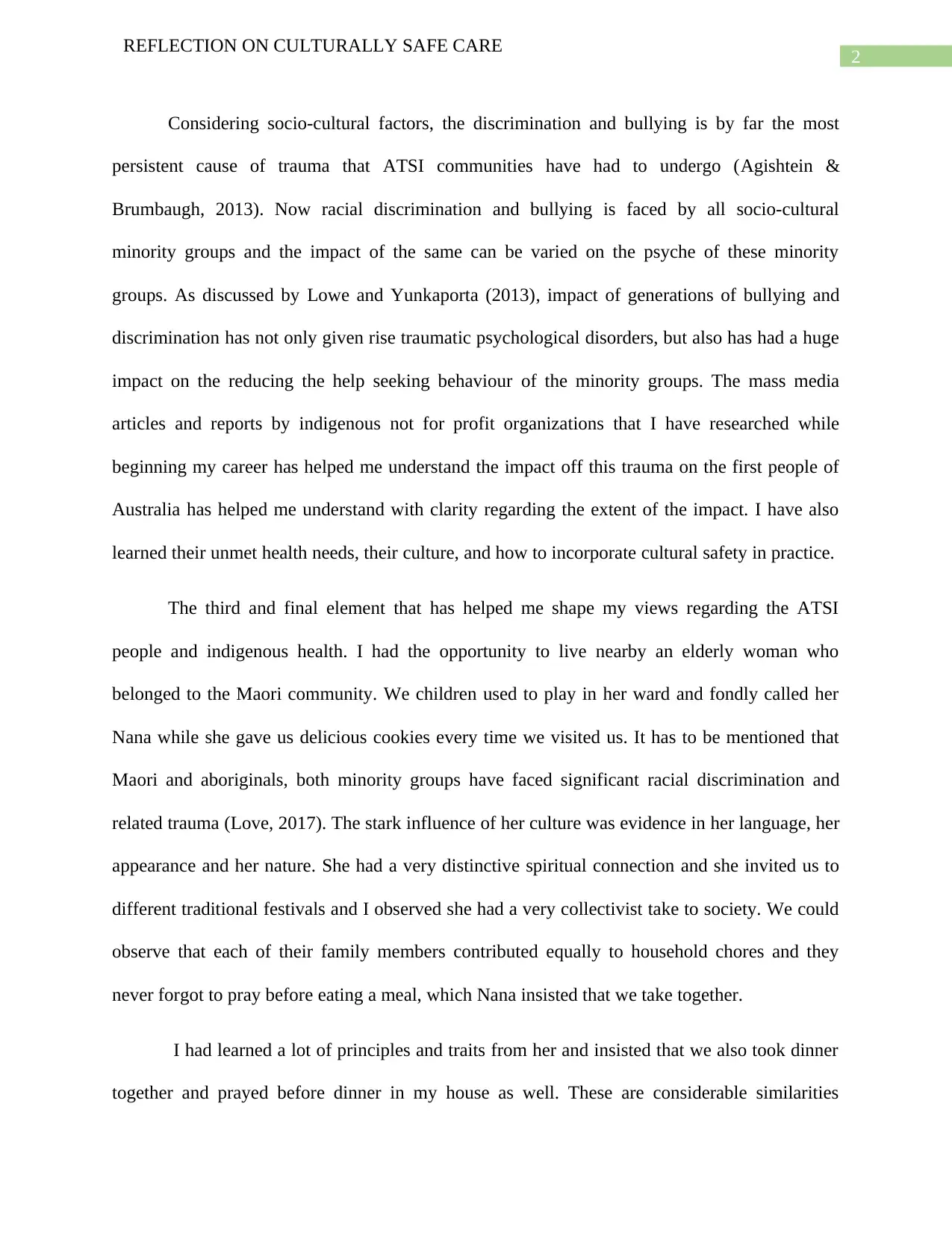
2
REFLECTION ON CULTURALLY SAFE CARE
Considering socio-cultural factors, the discrimination and bullying is by far the most
persistent cause of trauma that ATSI communities have had to undergo (Agishtein &
Brumbaugh, 2013). Now racial discrimination and bullying is faced by all socio-cultural
minority groups and the impact of the same can be varied on the psyche of these minority
groups. As discussed by Lowe and Yunkaporta (2013), impact of generations of bullying and
discrimination has not only given rise traumatic psychological disorders, but also has had a huge
impact on the reducing the help seeking behaviour of the minority groups. The mass media
articles and reports by indigenous not for profit organizations that I have researched while
beginning my career has helped me understand the impact off this trauma on the first people of
Australia has helped me understand with clarity regarding the extent of the impact. I have also
learned their unmet health needs, their culture, and how to incorporate cultural safety in practice.
The third and final element that has helped me shape my views regarding the ATSI
people and indigenous health. I had the opportunity to live nearby an elderly woman who
belonged to the Maori community. We children used to play in her ward and fondly called her
Nana while she gave us delicious cookies every time we visited us. It has to be mentioned that
Maori and aboriginals, both minority groups have faced significant racial discrimination and
related trauma (Love, 2017). The stark influence of her culture was evidence in her language, her
appearance and her nature. She had a very distinctive spiritual connection and she invited us to
different traditional festivals and I observed she had a very collectivist take to society. We could
observe that each of their family members contributed equally to household chores and they
never forgot to pray before eating a meal, which Nana insisted that we take together.
I had learned a lot of principles and traits from her and insisted that we also took dinner
together and prayed before dinner in my house as well. These are considerable similarities
REFLECTION ON CULTURALLY SAFE CARE
Considering socio-cultural factors, the discrimination and bullying is by far the most
persistent cause of trauma that ATSI communities have had to undergo (Agishtein &
Brumbaugh, 2013). Now racial discrimination and bullying is faced by all socio-cultural
minority groups and the impact of the same can be varied on the psyche of these minority
groups. As discussed by Lowe and Yunkaporta (2013), impact of generations of bullying and
discrimination has not only given rise traumatic psychological disorders, but also has had a huge
impact on the reducing the help seeking behaviour of the minority groups. The mass media
articles and reports by indigenous not for profit organizations that I have researched while
beginning my career has helped me understand the impact off this trauma on the first people of
Australia has helped me understand with clarity regarding the extent of the impact. I have also
learned their unmet health needs, their culture, and how to incorporate cultural safety in practice.
The third and final element that has helped me shape my views regarding the ATSI
people and indigenous health. I had the opportunity to live nearby an elderly woman who
belonged to the Maori community. We children used to play in her ward and fondly called her
Nana while she gave us delicious cookies every time we visited us. It has to be mentioned that
Maori and aboriginals, both minority groups have faced significant racial discrimination and
related trauma (Love, 2017). The stark influence of her culture was evidence in her language, her
appearance and her nature. She had a very distinctive spiritual connection and she invited us to
different traditional festivals and I observed she had a very collectivist take to society. We could
observe that each of their family members contributed equally to household chores and they
never forgot to pray before eating a meal, which Nana insisted that we take together.
I had learned a lot of principles and traits from her and insisted that we also took dinner
together and prayed before dinner in my house as well. These are considerable similarities
⊘ This is a preview!⊘
Do you want full access?
Subscribe today to unlock all pages.

Trusted by 1+ million students worldwide
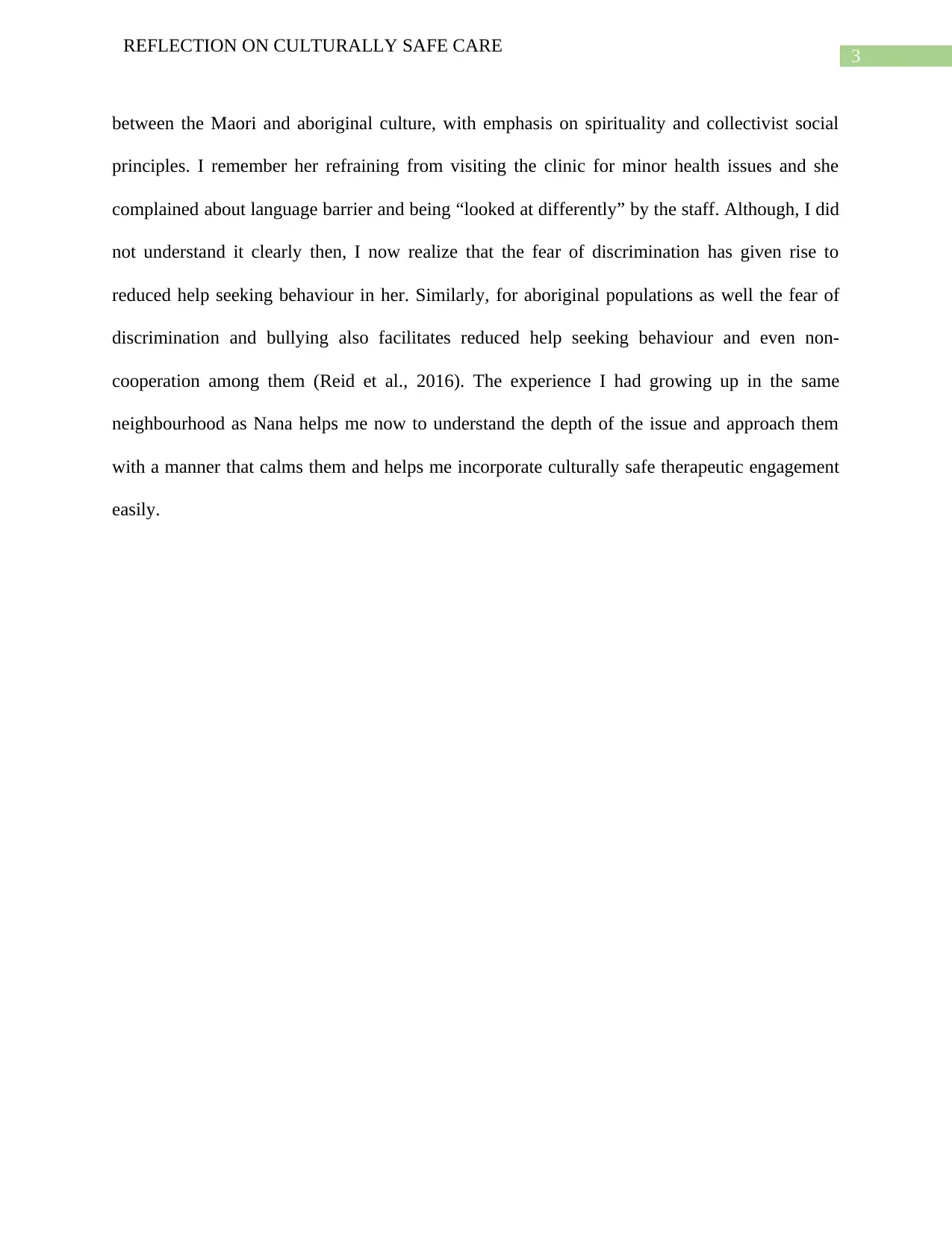
3
REFLECTION ON CULTURALLY SAFE CARE
between the Maori and aboriginal culture, with emphasis on spirituality and collectivist social
principles. I remember her refraining from visiting the clinic for minor health issues and she
complained about language barrier and being “looked at differently” by the staff. Although, I did
not understand it clearly then, I now realize that the fear of discrimination has given rise to
reduced help seeking behaviour in her. Similarly, for aboriginal populations as well the fear of
discrimination and bullying also facilitates reduced help seeking behaviour and even non-
cooperation among them (Reid et al., 2016). The experience I had growing up in the same
neighbourhood as Nana helps me now to understand the depth of the issue and approach them
with a manner that calms them and helps me incorporate culturally safe therapeutic engagement
easily.
REFLECTION ON CULTURALLY SAFE CARE
between the Maori and aboriginal culture, with emphasis on spirituality and collectivist social
principles. I remember her refraining from visiting the clinic for minor health issues and she
complained about language barrier and being “looked at differently” by the staff. Although, I did
not understand it clearly then, I now realize that the fear of discrimination has given rise to
reduced help seeking behaviour in her. Similarly, for aboriginal populations as well the fear of
discrimination and bullying also facilitates reduced help seeking behaviour and even non-
cooperation among them (Reid et al., 2016). The experience I had growing up in the same
neighbourhood as Nana helps me now to understand the depth of the issue and approach them
with a manner that calms them and helps me incorporate culturally safe therapeutic engagement
easily.
Paraphrase This Document
Need a fresh take? Get an instant paraphrase of this document with our AI Paraphraser
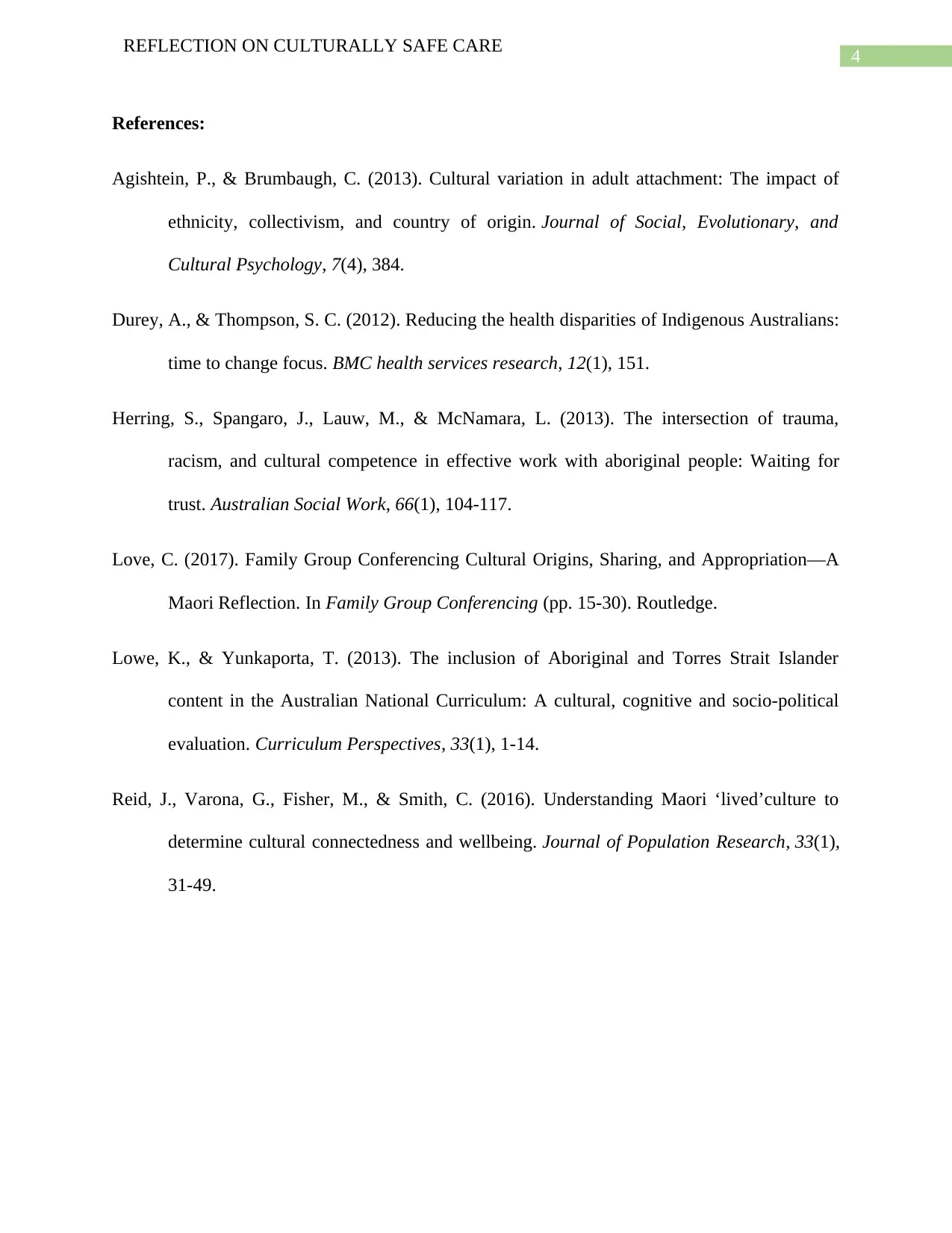
4
REFLECTION ON CULTURALLY SAFE CARE
References:
Agishtein, P., & Brumbaugh, C. (2013). Cultural variation in adult attachment: The impact of
ethnicity, collectivism, and country of origin. Journal of Social, Evolutionary, and
Cultural Psychology, 7(4), 384.
Durey, A., & Thompson, S. C. (2012). Reducing the health disparities of Indigenous Australians:
time to change focus. BMC health services research, 12(1), 151.
Herring, S., Spangaro, J., Lauw, M., & McNamara, L. (2013). The intersection of trauma,
racism, and cultural competence in effective work with aboriginal people: Waiting for
trust. Australian Social Work, 66(1), 104-117.
Love, C. (2017). Family Group Conferencing Cultural Origins, Sharing, and Appropriation—A
Maori Reflection. In Family Group Conferencing (pp. 15-30). Routledge.
Lowe, K., & Yunkaporta, T. (2013). The inclusion of Aboriginal and Torres Strait Islander
content in the Australian National Curriculum: A cultural, cognitive and socio-political
evaluation. Curriculum Perspectives, 33(1), 1-14.
Reid, J., Varona, G., Fisher, M., & Smith, C. (2016). Understanding Maori ‘lived’culture to
determine cultural connectedness and wellbeing. Journal of Population Research, 33(1),
31-49.
REFLECTION ON CULTURALLY SAFE CARE
References:
Agishtein, P., & Brumbaugh, C. (2013). Cultural variation in adult attachment: The impact of
ethnicity, collectivism, and country of origin. Journal of Social, Evolutionary, and
Cultural Psychology, 7(4), 384.
Durey, A., & Thompson, S. C. (2012). Reducing the health disparities of Indigenous Australians:
time to change focus. BMC health services research, 12(1), 151.
Herring, S., Spangaro, J., Lauw, M., & McNamara, L. (2013). The intersection of trauma,
racism, and cultural competence in effective work with aboriginal people: Waiting for
trust. Australian Social Work, 66(1), 104-117.
Love, C. (2017). Family Group Conferencing Cultural Origins, Sharing, and Appropriation—A
Maori Reflection. In Family Group Conferencing (pp. 15-30). Routledge.
Lowe, K., & Yunkaporta, T. (2013). The inclusion of Aboriginal and Torres Strait Islander
content in the Australian National Curriculum: A cultural, cognitive and socio-political
evaluation. Curriculum Perspectives, 33(1), 1-14.
Reid, J., Varona, G., Fisher, M., & Smith, C. (2016). Understanding Maori ‘lived’culture to
determine cultural connectedness and wellbeing. Journal of Population Research, 33(1),
31-49.
1 out of 5
Related Documents
Your All-in-One AI-Powered Toolkit for Academic Success.
+13062052269
info@desklib.com
Available 24*7 on WhatsApp / Email
![[object Object]](/_next/static/media/star-bottom.7253800d.svg)
Unlock your academic potential
Copyright © 2020–2025 A2Z Services. All Rights Reserved. Developed and managed by ZUCOL.





